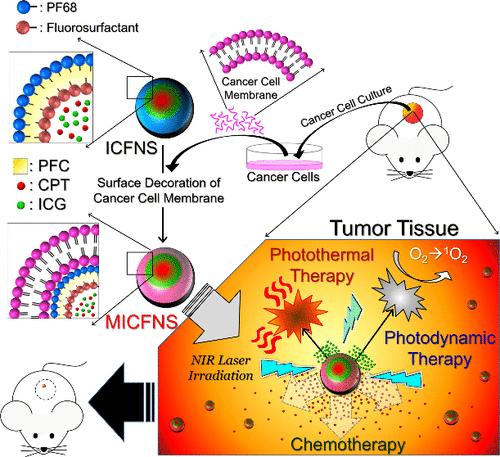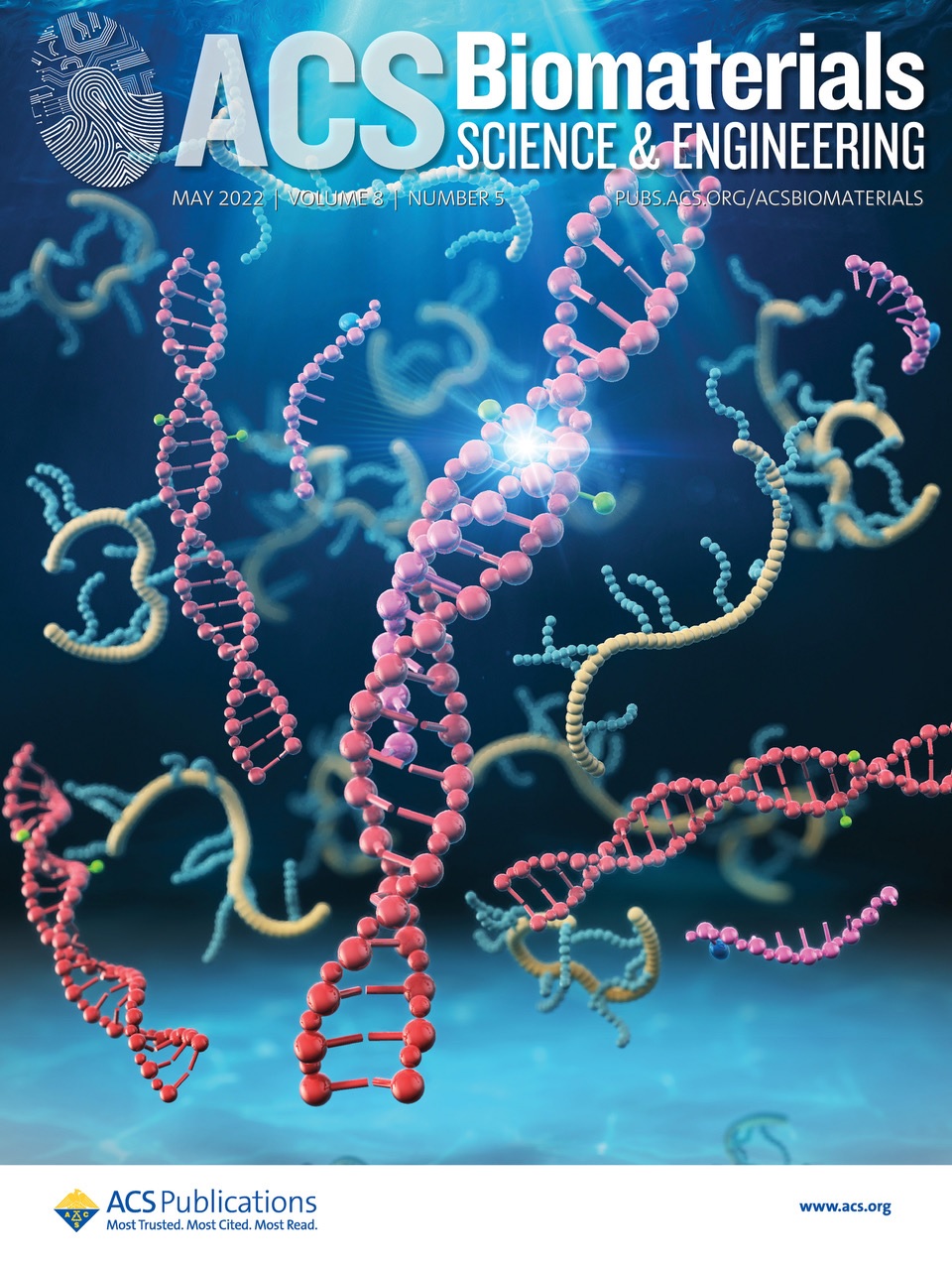Carcinomembrane-Camouflaged Perfluorochemical Dual-Layer Nanopolymersomes Bearing Indocyanine Green and Camptothecin Effectuate Targeting Photochemotherapy of Cancer
IF 5.4
2区 医学
Q2 MATERIALS SCIENCE, BIOMATERIALS
引用次数: 0
Abstract
Photochemotherapy has been recognized as a promising combinational modality for cancer treatment. However, difficulties such as off-target drug delivery, systemic toxicity, and the hypoxic nature of the tumor microenvironment remain hindrances to its application. To overcome these challenges, cancer cell membrane camouflaged perfluorooctyl bromide (PFOB) dual-layer nanopolymersomes bearing indocyanine green (ICG) and camptothecin (CPT), named MICFNS, were developed in this study, and melanoma was exploited as the model for MICFNS manufacture and therapeutic application. Our data showed that MICFNS were able to stabilize both ICG and CPT in the nanocarriers and can be quickly internalized by B16F10 cells due to melanoma membrane-mediated homology. Upon NIR irradiation, MICFNS can trigger hyperthermia and offer enhanced singlet oxygen production due to the incorporation of PFOB. With ≥10/2.5 μM ICG/CPT, MICFNS + NIR can provide comparable in vitro cancericidal effects to those caused by using an 8-fold higher dose of encapsulated CPT alone. Through the animal study, we further demonstrated that MICFNS can be quickly brought to tumors and have a longer retention time than those of free agents in vivo. Moreover, the MICFNS with 40/10 μM ICG/CPT in combination with 30 s NIR irradiation can successfully inhibit tumor growth without systemic toxicity in mice within the 14 day treatment. We speculate that such an antitumoral effect was achieved by phototherapy followed by chemotherapy, a two-stage tumoricidal process performed by MICFNS. Taken together, we anticipate that MICFNS, a photochemotherapeutic nanoplatform, has high potential for use in clinical anticancer treatment.

含吲哚菁绿和喜树碱的癌膜-伪装全氟化学双层纳米聚合物团可对癌症进行靶向光化学治疗
光化学疗法已被认为是一种很有前景的癌症综合治疗方法。然而,脱靶给药、全身毒性和肿瘤微环境的缺氧性等困难仍然阻碍着光化学疗法的应用。为了克服这些难题,本研究开发了含吲哚菁绿(ICG)和喜树碱(CPT)的癌细胞膜伪装全氟溴化辛基(PFOB)双层纳米多聚体,命名为MICFNS,并以黑色素瘤作为MICFNS的制造和治疗应用模型。我们的数据显示,MICFNS 能够将 ICG 和 CPT 稳定在纳米载体中,并且由于黑色素瘤膜介导的同源性,MICFNS 能够被 B16F10 细胞快速内化。在近红外辐照下,MICFNS 可引发热效应,并由于掺入了 PFOB 而增强了单线态氧的产生。在 ICG/CPT ≥10/2.5 μM 的情况下,MICFNS + 近红外的体外杀癌效果与单独使用高 8 倍剂量的封装 CPT 所产生的效果相当。通过动物实验,我们进一步证实了 MICFNS 在体内可迅速到达肿瘤,且与游离制剂相比具有更长的滞留时间。此外,含有 40/10 μM ICG/CPT 的 MICFNS 与 30 秒的近红外照射相结合,可在 14 天的治疗期内成功抑制小鼠的肿瘤生长,且无全身毒性。我们推测,这种抗肿瘤效果是通过光疗和化疗实现的,这是 MICFNS 的两阶段杀瘤过程。综上所述,我们认为 MICFNS 这种光化学治疗纳米平台在临床抗癌治疗中具有很大的应用潜力。
本文章由计算机程序翻译,如有差异,请以英文原文为准。
求助全文
约1分钟内获得全文
求助全文
来源期刊

ACS Biomaterials Science & Engineering
Materials Science-Biomaterials
CiteScore
10.30
自引率
3.40%
发文量
413
期刊介绍:
ACS Biomaterials Science & Engineering is the leading journal in the field of biomaterials, serving as an international forum for publishing cutting-edge research and innovative ideas on a broad range of topics:
Applications and Health – implantable tissues and devices, prosthesis, health risks, toxicology
Bio-interactions and Bio-compatibility – material-biology interactions, chemical/morphological/structural communication, mechanobiology, signaling and biological responses, immuno-engineering, calcification, coatings, corrosion and degradation of biomaterials and devices, biophysical regulation of cell functions
Characterization, Synthesis, and Modification – new biomaterials, bioinspired and biomimetic approaches to biomaterials, exploiting structural hierarchy and architectural control, combinatorial strategies for biomaterials discovery, genetic biomaterials design, synthetic biology, new composite systems, bionics, polymer synthesis
Controlled Release and Delivery Systems – biomaterial-based drug and gene delivery, bio-responsive delivery of regulatory molecules, pharmaceutical engineering
Healthcare Advances – clinical translation, regulatory issues, patient safety, emerging trends
Imaging and Diagnostics – imaging agents and probes, theranostics, biosensors, monitoring
Manufacturing and Technology – 3D printing, inks, organ-on-a-chip, bioreactor/perfusion systems, microdevices, BioMEMS, optics and electronics interfaces with biomaterials, systems integration
Modeling and Informatics Tools – scaling methods to guide biomaterial design, predictive algorithms for structure-function, biomechanics, integrating bioinformatics with biomaterials discovery, metabolomics in the context of biomaterials
Tissue Engineering and Regenerative Medicine – basic and applied studies, cell therapies, scaffolds, vascularization, bioartificial organs, transplantation and functionality, cellular agriculture
文献相关原料
| 公司名称 | 产品信息 | 采购帮参考价格 |
|---|
 求助内容:
求助内容: 应助结果提醒方式:
应助结果提醒方式:


